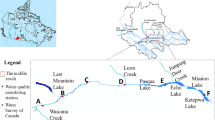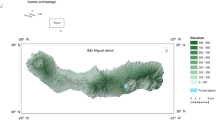Abstract
The surface water quality of the upper South Saskatchewan River was modelled using Water Quality Analysis Simulation Program (WASP) 7.52. Model calibration and validation were based on samples taken from four long-term water quality stations during the period 2007–2009. Parametric sensitivities in winter and summer were examined using root mean square error (RMSE) and relative entropy. The calibration and validation results show good agreement between model prediction and observed data. The two sensitivity methods confirmed pronounced parametric sensitivity to model state variables in summer compared to winter. Of the 24 parameters examined, dissolved oxygen (DO) and ammonia (NH3-N) are the most influenced variables in summer. Instream kinetic processes including nitrification, nutrient uptake by algae and algae respiration induce a higher sensitivity on DO in summer than in winter. Moreover, in summer, soluble reactive phosphorus (SRP) and chlorophyll-a (Chla) variables are more sensitive to algal processes (nutrient uptake and algae death). In winter however, there exists some degree of sensitivity of algal processes (algae respiration and nutrient uptake) to DO and NH3-N. Results of this study provide information on the state of the river water quality which impacts Lake Diefenbaker and the need for additional continuous monitoring in the river. The results of the sensitivity analysis also provide guidance on most sensitive parameters and kinetic processes that affect eutrophication for preliminary surface water quality modelling studies in cold regions.












Similar content being viewed by others
References
Ambrose RB (1992) Technical guidance manual for performing waste load allocations, book III: estuaries, Part 4: critical review of coastal embayment and estuarine waste load allocation modeling. USEPA, Office of Water, Washington, pp 10–18
Ambrose RB, Wool TA (2009) WASP7 stream transport - model theory and user's guide. U.S. Environmental Protection Agency, Athens, GA. http://nepis.epa.gov/Adobe/PDF/P1005O7C.PDF
Ambrose RB, Wool TA, Martin JL (1993) The water quality simulation program, WASP5: model theory, user’s manual, and programmer’s guide. U.S. Environmental Protection Agency, Athens, GA. http://sdi.odu.edu/mbin/wasp/dos/wasp5_model.pdf
Babin J, Trew DO (1985) The impact of the proposed Sand River reservoir on winter dissolved oxygen levels in the Beaver and Sand rivers. Pollution Control Div., Water Quality Control Branch, Alberta Environment, Edmonton
Bierman VJ, Dolan DM (1986) Modeling of phytoplankton in Saginaw Bay—calibration phase. J Environ Eng 112(2):400–403
Burke A (2013) Water quality in the South Saskatchewan River basin. South Saskatchewan River WatershedStewards.http://southsaskriverstewards.ca/water-quality-assessment.html. Accessed 27 June 2014
Byrne J, Kienzle S, Johnson D, Duke G, Gannon V, Selinger B, Thomas J (2006) Current and future water issues in the Oldman river basin of Alberta, Canada. Water Sci Technol 53(10):327–334
Carr M, Lacho C, Pollock M, Watkinson D, Lindenschmidt K-E (2014) A first tier desktop approach for identifying lake sturgeon (Acipenser fulvescens) habitat in the Saskatchewan River System. River Systems: 1–14. doi: 10.1127/1868-5749/2014/0086
Casey A (2010) The drying South Saskatchewan River. Can Geogr. http://www.canadiangeographic.ca/magazine/oct10/south_saskatchewan_river.asp
Chapra SC (1997) Surface water-quality modeling. McGraw Hill Companies, Inc
Chen C-H, Lung W-S, Li S-W, Lin C-F (2011) Technical challenges with BOD/DO modeling of rivers in Taiwan. J Hydro Environ Res 6(1):3–8. doi:10.1016/j.jher.2011.08.001, March 2012
Chen Q, Wu W, Blanckaert K, Ma J, Huang G (2012) Optimization of water quality monitoring network in a large river by combining measurements, a numerical model and matter-element analyses. J Environ Manag 110(2012):116e124. doi:10.1016/j.jenvman.2012.05.024
Darbellay GA, Wuertz D (2000) The entropy as a tool for analysing statistical dependences in financial time series. Phys A 87:429–439
Diduck S (1989) South Saskatchewan River water quality modeling. technical report D.10. Canada-Saskatchewan South River basin study. Water Quality Branch, Saskatchewan Environment and Public Safety, Regina, Saskatchewan
EPA (1997) Technical guidance manual for performing wasteload allocations, book II: streams and rivers. EPA#: 823/B-97-002
EPA (2013) Model set-up and calibration for Mckay Bay. U.S. Environmental Protection Agency
Kelso JRM, MacCrimmon HR (1969) Diel and seasonal variations in physiochemical limnology, Speed River, Ontario. Water Resour Res 5(6):1388–1394
Koning CW, Saffran KA, Little JL, Fent L (2006) Water quality monitoring: the basis for watershed management in the Oldman River basin, Canada. Water Sci Technol 53(10):153–161
Kwak J, Khang B, Kim E, Kim H (2013) Estimation of biochemical oxygen demand based on dissolved organic carbon, UV absorption and fluorescence measurements. J Chem 2013:1–9
Lindenschmidt K-E, Chun KP (2014) Geospatial modelling to determine the behaviour of ice cover formation during freeze-up of the Dauphin River in Manitoba. Hydrol Res 45(4–5):645–659
Lindenschmidt K-E, Pech I, Baborowski M (2009) Environmental risk of dissolved oxygen depletion of diverted flood waters in river polder systems—a quasi-2D flood modelling approach. Sci Total Environ 407(5):1598–1612
MacKay DJC (2003) Information theory, inference, and learning algorithms. Cambridge University Press, Cambridge. ISBN 0-521-64298-1
Martin N, McEachern P, Yu T, Zhu DZ (2012) Model development for prediction and mitigation of dissolved oxygen sags in the Athabasca River, Canada. Sci Total Environ 443:403–412. doi:10.1016/j.scitotenv.2012.10.030
McConkey S, Bartosova A, Lin L-S, Andrew A, Machesky M, Jennings C (2004) Fox river watershed investigation – Stratton dam to the Illinois river: water quality issues and data report to the Fox River Study Group Inc., Illinois State Water Survey, contract 2004-06. http://www.sws.uiuc.edu/pubdoc/cr/iswscr2004-06.pdf
McDonals D, Muricken D (2009) North Saskatchewan River water quality model: Alberta Environment Technical Report. Water Policy Branch, Alberta Environment
Morales-Marin L, Wheater H, Lindenschmidt K-E (2015) Assessing the transport of total phosphorus from a prairie river basin using SPARROW. http://onlinelibrary.wiley.com/doi/10.1002/hyp.10555/asbstract
Prowse TD (2001) River-ice ecology: part A) hydrologic, geomorphic and water-quality aspects. J Cold Reg Eng 15:1–16
Robinson KL, Valeo C, Ryan MC, Chu A, Iwanyshyn M (2009) Modelling aquatic vegetation and dissolved oxygen after a flood event in the Bow River, Alberta, Canada. Can J Civ Eng 36(3):492
Ruszchi C (2010) Water quantity in the south Saskatchewan River sub-basin. SEAWA Watershed Report 2010-9. South East Alberta Watershed Alliance
Sadeghian A, Hudson J, Wheater H, Lindenschmidt K-E (2014) Water quality modeling of Lake Diefenbaker. Water news. Can Water Res Assoc 33(2):17–20
Saltelli A, Chan K, Scott EM (2000) Sensitivity analysis. Wileys series in probabilities and statistics. Wiley, London
Schallock EW, Lotspeich FB (1974) Low winter dissolved oxygen in some Alaskan rivers. EPA-660/3-74-008, Off. of Res. and Devel. U.S. Environmental Protection Agency, Corvallis
Shakibaeinia A, Dibike YB, Prowse TD (2014) Numerical modelling of dissolved-oxygen in a cold-region river. In: Ames DP, Quinn NWT, Rizzoli AE (eds) Proceedings of the 7th International Congress on Environmental Modelling and Software, San Diego, California, USA, 15–19 June 2014
Shu, W.-P. (2004) The use of a water quality model to evaluate the impact of combined sewer overflow on the lower Hudson River. PhD Thesis, Department of Civil and Environmental Engineering, Faculty of New Jersey Institute of Technology, New Jersey, USA, 222 pp
Singh VP (1999) The entropy theory as a tool for modelling and decision making in environmental and water resources. Water SA 26:1–12
Wang Q, Li S, Jia P, Qi C, Ding F (2013) A review of surface water quality models. Sci World J 2013, 231768. doi:10.1155/2013/231768, 7 pages
Weijs S, van de Giesen N (2010) Information theory, uncertainty and risk for evaluating hydrologic forecasts. International Workshop on Advances in Statistical Hydrology, 23–25 May 2010, Taormina, Italy, pp 1–11. http://www.risorseidriche.dica.unict.it/Sito_STAHY2010_web/pdf_papers/Weijs_vandeGiesen.pdf
Wool TA, Ambrose RB, Martin JL, Comer EA (2001) Water quality analysis simulation program (WASP) version 6.0 draft: user' s manual. US Environmental Protection Agency-Region 4, Atlanta
Author information
Authors and Affiliations
Corresponding author
Additional information
Responsible editor: Michael Matthies
Rights and permissions
About this article
Cite this article
Akomeah, E., Chun, K.P. & Lindenschmidt, KE. Dynamic water quality modelling and uncertainty analysis of phytoplankton and nutrient cycles for the upper South Saskatchewan River. Environ Sci Pollut Res 22, 18239–18251 (2015). https://doi.org/10.1007/s11356-015-4970-0
Received:
Accepted:
Published:
Issue Date:
DOI: https://doi.org/10.1007/s11356-015-4970-0




